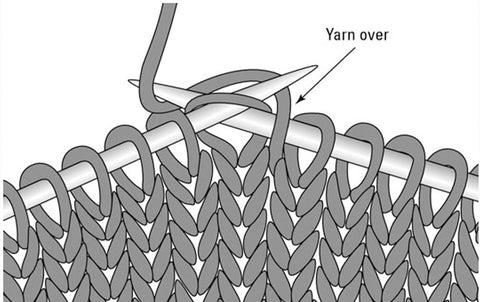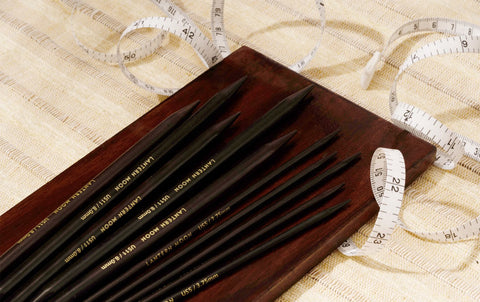
Are you captivated by the beauty of lace knitting? Are you intimidated by the intricate patterns and delicate motifs? The aesthetic art of knitting lace requires your favorite knitting needles, accessories, yarn, and some simple techniques. In this blog, we'll explore the fundamentals of lace knitting and understand stitch patterns and essentials. So, let's get started.
Understanding Lace Knitting
Fundamentally, lace knitting involves creating decorative holes within your fabric. While you work knit and purl stitches, you combine them by strategically increasing and decreasing stitches. These eyelets are arranged in intricate patterns to form beautiful designs. Unlike traditional knitting, lace incorporates knitting needle sizes bigger than the matching yarn weight. For example, pair a DK light worsted yarn with needles that are 5mm (US 8)-8 mm (US 11). Your stitches will have an open effect, but that is not lace; it only looks like it. For beginners, it is best to work with a pattern to get it right.
Lace Knitting Stitches and Techniques
Before diving into lace knitting, it's essential to familiarize yourself with the basic stitches and techniques, including knit, purl, increases and decreases to achieve its airy and ethereal appearance. Practice these stitches until you feel comfortable executing them consistently. To be more proficient with the stitch techniques, first work on them on single-pointed needles or circulars for back-and-forth knitting. Move on to knitting in the round with DPNs or circular needles.
Knitting Increases
Yarn Over (YO)— The knitting increase technique is one of the basics of lace patterns. When you yarn over, you bring the yarn to the front of the work (as if to purl) and then knit the next stitch, which makes an extra stitch that forms a hole or eyelet in the fabric.

Double Yarn Over (YO2)— As the name suggests, double yarn over (YO2) means two yarn overs, resulting in two eyelets side by side. You simply need to bring the yarn to the front, wrap it twice around the needle and knit the next stitch.
Knit Front and Back (KFB)— To increase a stitch and form a hole in the knitted fabric, knit into the front loop of the stitch. But before slipping the stitch off the needle, knit into the back loop of the same stitch.
M1R/ M1L— When you make one stitch right, you create a right-leaning increase, while making one stitch to the left will create a left-leaning increase. Both can be used according to the pattern requirements.
Knitting Decreases
Knit Two Together (K2tog)— The common decrease stitch works beautifully in lace patterns. You simply knit two stitches together and balance the increases in the pattern. The stitch slants to the right, creating a neat diagonal line in the fabric.
Slip, Slip, Knit (SSK)— The left-leaning decrease complements the K2tog decrease. To work on SSK, slip the two stitches knitwise one at a time onto the needle, insert the needle into the front loops of the slipped stitches, and knit them together. This balances the artful spaces created in lace patterns.
Central Double Decrease (CDD)— This knitting decrease reduces three stitches into one without left or right slants. To execute this stitch, insert the needle into the following two stitches as if to knit them together, then knit the next stitch. Finally, pass the two knitted stitches over the third stitch and off the needle.
Slipped Stitch Edges— Slipped stitches are a basic technique used for lace patterns. They are neither an increase nor a decrease but are used to create a neat and defined edge.
With these basic stitch techniques, you can work on any lace knitting pattern. For your beginner projects, it is recommended that you work with a pattern. And, as you advance you can knit delicate patterns with your hand.
Besides creating magic with your knitting needles, there are many other factors that assist with lace patterns.
Choosing the right needles and yarn

The right combination of knitting needles and yarn is essential for lace patterns. If you are following a pattern, you have the needle sizes and yarn weight. But, first knit a swatch to see if you are getting it right.
Blocking Your Lace Knitting
Blocking is a crucial step in finishing lace knitting projects. When you block your knitted fabric, it helps open up the lace pattern, evens out stitches, and enhances the drape of the fabric. To block your lace knitting, gently soak your finished piece in lukewarm water with a mild detergent, then carefully shape it to the desired dimensions and pin it in place. Allow your project to dry completely before removing it.
As with any new skill, practice is key to mastering lace knitting. Start with small swatches or simple projects to gradually build your confidence and skills. Don't be discouraged by mistakes—view them as opportunities to learn and improve your technique. If you are a beginner, the intricate art may seem daunting but with patience, practice, and perseverance, you'll soon be a master of the craft. So gather your yarn and needles, choose a beautiful lace pattern, and let your creativity take flight.
Beautiful lace knitting works beautifully with prized knitting needles. The Lantern Moon knitting needles are a handcrafted beauty that enhances your knitting experience. The smooth ebony wood needles have a liquid silk finish that effortlessly glides through all kinds of yarn. Happy knitting!
